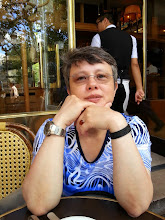"The Jar of Apricots", 1758, Jean Siméon Chardin, Oil on Oval Canvas, 57 x 51 cm, Art Gallery of Ontario, Canada
"You have to train the eye to look at nature; and how many have never seen it and never will". It was with these few words to the 18th Century French philosopher Denis Diderot, at the Salon of 1765, that Chardin accounted for his special relationship with still-life painting. Although, "The Jar of Apricots" belongs to Chardin's first still-life period (from 1724 to 1734), this unusual oval format seem to herald what will become the painter's most distinguished signature; the spiritualization of matter. Matter? And what matter(s) really? Nature? Life like painting? Painting? Or the very act of looking at a painting?
"The Jar of Apricots" and its pendant "The Cut Melon" (1762), were two of the eight paintings Chardin sent to the Salon of 1761, but it was hardly noticed. Perhaps, this was due to the painter's peculiar choice of oval format, which emphasizes the harmony of the composition? It may also have been a reaction to the painter's frame, which naturally excludes all possiblities for the anecdotal. It is as if Chardin wanted us to focus on what was going on within the pictorial space, and no longer on what it was supposed to represent. Do you follow? Usually, in still-life painting, the emphasis is on the objects, the symbols they represent and the level of realism these have reached. In short, the viewer's gaze is 'scattered' along the painting, often beguiled by the painter's mastery in playing with textures, volumes, colours, light, etc. What was then going on in "The Jar of Apricots"? Hardly anything noticeable over a quick look. Let us look closer, then.
A jar of apricots, of course, then the two teacups echoing the three wine glasses on the left handside of the painting, the almond macaroons, an orange, the knife handle- to give a depth effect - the box of sugar almonds, the sugar loaf (a true luxury, at that time) wrapped in blue paper and finally the mysterious brown package tied with a string. What is so special about this painting? The extreme compactness of his composition, a natural movement of the eye towards the upper part of the painting, the transparency of the left handside objects that is balanced with the opacity of the right handside props. Normally, with such a format - rather crowded with objects - it is easy to feel claustrophobic, yet I do not feel like that, at all. Quite the contrary. Why?
I submit, this is partly due to Chardin's unique talent in using a gentle chromatic chord, the discreet smoke of the teacup in the middle of the composition, which allow the painting to breathe, and the viewer with it. Also, the bare background of the painting - a typical brownish, timeless setting - never a pure colour, but a patient scumbling which slowly reveals its secret. Secret? It is not for nothing that Chardin was often referred to by Diderot, as the great magician. There is something truly bewildering and poetic about his still-lifes. Ok, let us pause for a moment and see what we are left with, so far. A still-life in an oval format - the keyhole format - an apparently lifeless painting, a strive towards plastic simplicity and the truth. Yet, all these qualities cannot alone account for the quality of presence, "The Jar of Apricots" retains.
What if Chardin went a step further, and was able to create an inner world - yet, accessible to the attentive eye - in which objects no longer refer to the realm of doing, but that of being? What if the true subject of his still-lifes was to give a physical expression to silence and the visible? I ventured earlier, that Chardin's spiritualized matter. How did one do that? I looked back at the background of this painting, and I was struck again by its mirror like quality. Mirror? There is a strange light that seems to exsude from the background, slowly making its way to the person who just left the pictorial space, the human being who likes to eat almond macaroons with his tea and took the time to set the table with a great attention to details.
Perhaps, what Chardin achieved was to demonstrate that we never look at things from a single point of view. In a way, looking is also connecting. To what is before the eye, as well as beyond. Beyond? In order to bring out the essence of things, one needs only to observe their outward appearance. Then, proceed with caution and love, open oneself to serendipity and listen. Listen? Yes, listen to the voice of things, to what was once our presence, within and beyond the painting.













No comments:
Post a Comment